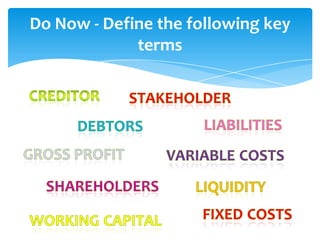
3.3 using financial data to measure and assess performance (part 3) - moodle
- 1. Do Now - Define the following key terms
- 2. Using financial data to measure and assess performance (Part 3)
- 3. Learning Objectives By the end of this lesson you should be able to: 1. Understand the structure of a balance sheet. 2. Understand how balance sheets are used to assess performance and potential. 3. Understand how to select, calculate and interpret financial ratios to assess performance.
- 4. Basic principles of a balance sheet Accurate balance sheets must obey the following principle: all assets must equal all liabilities Which means that: where money where money has been must equal came from spent Why is it so crucial assets and liabilities balance?
- 5. 1) Non-current assets (fixed assets) Fixed assets are those which the business actually owns and which are therefore ‘fixed’ into the company. Include buildings and furniture fittings, machinery and company vehicles. Cost a lot of money and represent a large investment for the business. last for a long period of time. Can be sold to increase capital (i.e. the money invested in the business). Fixed assets are those that have a useful life in excess of one year.
- 6. 2) Current assets Current assets are those which the business holds temporarily or that are always changing on a day-to-day basis. Including inventories (stock), cash or trade receivables (debtors). For example: A shop, the value of the stock is a current asset. An interior designer working on a job for a client, the work in progress is a current asset. The final main types of current asset are customers who owe money for goods bought Trade Receivables (debtors) and also the amount of money in a company’s current bank account.
- 7. 3) Current liabilities Current liabilities, like current assets, are short-term and always changing. However, this is money that a business actually owes. Common current liabilities include: short-term loans Trade Payables (Creditors) bank overdrafts share dividend payments. Current liabilities are those that are expected to be paid back in one year.
- 8. 4) Non-current liabilities (Long term liabilities/ loans) Non-Current liabilities relate to money owed to be paid back over a longer period of time. Common non-current liabilities include: Mortgages Loans Current liabilities are those that are to be paid back over a longer period of time.
- 10. 5) Total Equity The total amount if money being utilised in the business from share capital and retained profit. Share capital – money which shareholders have invested in the business. Reserves – profit from previous years which has been retained to finance future developments. Profit and loss account – money kept back from the current year’s profits (the net profit). Why is the money personally invested by a business a liability and not an asset?
- 11. Let’s look at the structure of balance sheets
- 12. Practice! Although you won’t need to create a balance sheet in an examination it is good for you to understand how they work.
- 13. Reading a balance sheet Both the balance sheet and the profit and loss account show the ‘health’ of the business. Shareholders, customers, suppliers, employees and other stakeholders will be interested in both types of account. They will want to see how the business is getting its money (e.g. whether it is borrowing large amounts of money or whether it is using profits) and how well and on what this money is used.
- 14. Important balance sheet considerations It is important for companies to bear in mind the following considerations when preparing balance sheets: Fixed assets – is there enough money secured in items which could be sold to raise capital? Or is there too large an investment in fixed assets and not enough liquidity (the ability to meet current liabilities) in the business? Cash in bank – can a short-term crisis be covered? Net current assets/liabilities – if this figure is negative, the business hasn’t enough money to pay all its debts in a reasonable time, if required. Shareholders’ funds – are these increasing? Shareholders will want their investment to grow.
Notes de l'éditeur
- Working Capital = A measure of a firms ability to meet day-to-day expenses. If can’t generate enough cash in the short-term then they may have to liquidate fixed assets (may not be able to operate).Liquidity = A businesses ability to meet short-term/ day-to-day cash payments on time. Depreciation = An accounting practice that allows the value of a fixed asset to be spread over it’s useful life. It is classed as an expense in the income statement.
- Debtors (Receivables) – too high – may mean a lot of competition in the market or that the firm needs to tighten up credit control.Creditors (Payables) – too low – may consider improving cash flow and negotiate better payment terms. Alternatively may get discounts for early payment.